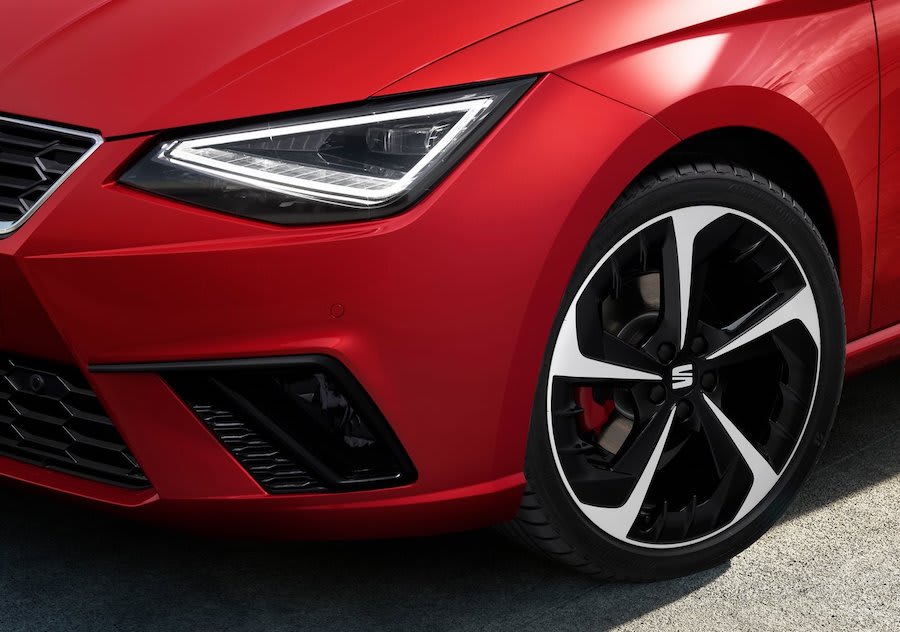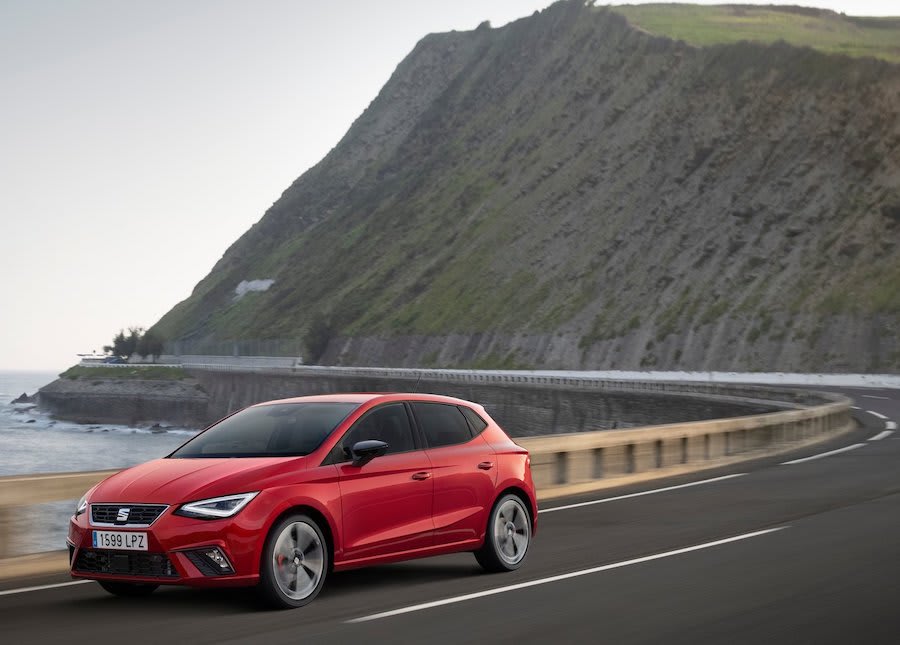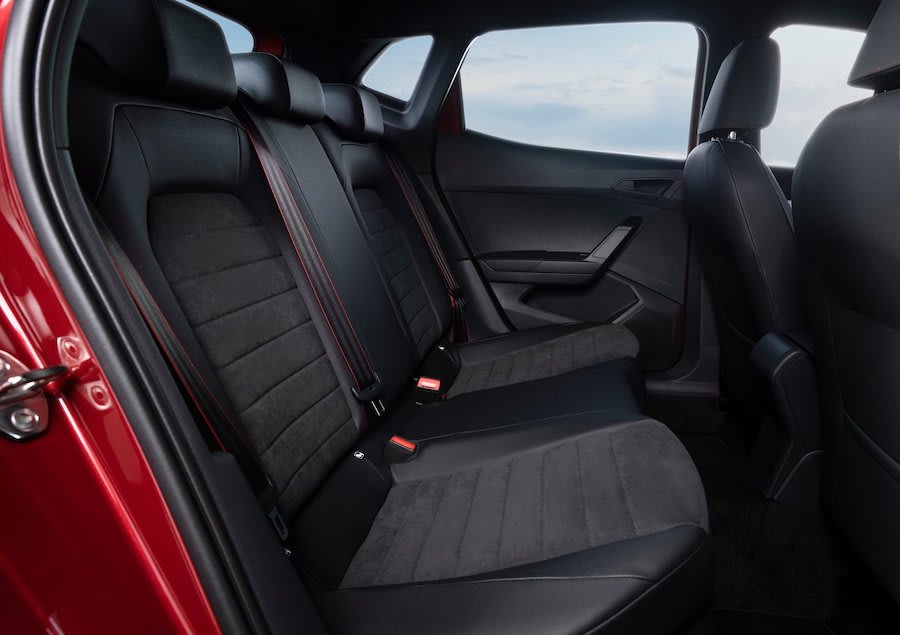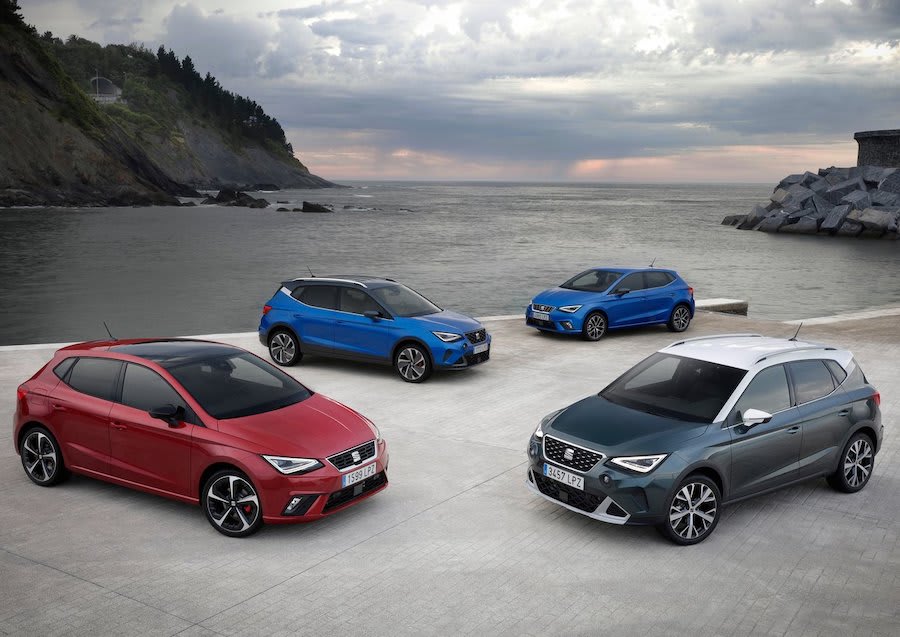.jpg)
New Seat Ibiza Review
.jpg)
Introduction
It is hard to believe that the SEAT Ibiza has been around since 1984. Now on its fifth edition, the current version of the Ibiza has been on sale since 2017.
That means it's due a face-lift, and the German-owned Spanish-native brand has duly obliged with new technology and some significant updates to the interior.
Select's rating score* - 3.9 / 5
At a Glance
From the outside, it’s hard to tell any difference.
The front now boasts LED lights as standard across the range, and there's a fresh selection of alloy wheels. The badging has been changed, too, with the word ‘Ibiza’ written in joined-up lower-case letters along the back, handwritten-style.
There's no real change other than that, but these subtle additions make the Ibiza more attractive.
The triangular headlights at the front point inwards towards the grille, with diagonal body-coloured lines beneath, either side of a second lower grille, with angled fog lights at each end revealing an aggressive, sporty stance.

Down the side, a cleaner design features an angled rear window, with a neat crease in the lower part of the door above a modest side skirt.
As has been the tendency in the SEAT range, the back is far more modest, with the rear lights pointing inwards, like the front, but less aggressively. The new Ibiza hand-written lettering on the back adds a classy touch, almost at odds with the sportiness of the front. But it’s arguably taking inspiration from the likes of Alfa Romeo here – who provide proof that classiness and sportiness can go together very well indeed – so who are we to judge?
Overall, the Ibiza continues its trend of being pleasing to the eye.
It is well proportioned, with, arguably, a more attractive stance than ever before, and it’s not hard to see why it’s SEAT’s best-selling model.
Although its HQ is still based in Martorell, just outside Barcelona, the Catalonian manufacturer has benefitted from three decades of German engineering since being taken over by the Volkswagen group in 1990. That means, in effect, what you’re getting is an engineering standard that should match that of a VW Polo or a Golf.

Key Features
The facelifted Ibiza comes with a modest 1.0-litre petrol engine.
This might be bad news for those who equate sportiness with engine size, but this is the back end of 2021. So out go the 1.6-litre engines of old, although those who want something sporty might be pleased that there are now no diesels.
The new engine comes in three variants – 80PS, 95PS and 110PS.
You’ll get a five-speed manual in the lower two, while the 110PS engine comes with a six-speed manual and is also available as a seven-speed automatic.

There are six trims to choose from.
Entry-level SE gets you 15-inch alloys, electric door mirrors, solid or metallic paint (at no extra cost), six speakers and a DAB radio. You also get Bluetooth connectivity, air conditioning, automatic LED headlights, as well as an 8.25-inch touchscreen infotainment system.
SE Technology is up next, upgrading the alloys to 16-inches, while the infotainment screen gets an increase, too, to 9.2-inches, with SatNav included.
FR increases the size of the wheels again to 17-inches, while sports seats are added inside, along with cruise control and a sportier handling setup. You also get black painted door mirrors, which are electrically foldable, sportier rear bumpers and dark-tinted rear windows. Plus, dual-zone climate control, automatic windscreen wipers and an alarm are part of the kit.
FR Sport again boosts the rims, this time to 18-inches. It also adds sports suspension, SEAT’s Digital Cockpit (consisting of a digital instrument display), as well as microsuede upholstery.
Xcellence trim only has 17-inch alloys but adds in keyless entry and go (although you lose the Digital Cockpit).
The top-of-the-range is Xcellence Lux. This grade throws in a rear-view camera, plus SEAT Drive Profile, which means you can choose from Normal, Sport, Eco and Individual driving modes, plus improved steering and throttle response. The Digital Cockpit is included.

Performance & Drive
The mid-range 95PS engine is expected to be the best-seller as a nice compromise between power and price. And that’s what we’re testing here in FR trim.
At low speeds around town, it performs well, with exact and smooth gear changes.
Outright acceleration does feel slightly limited by the small engine, and we suspect those of a sporty disposition will appreciate the extra grunt of the top-of-the-range unit. Nevertheless, the 95PS powerplant still pulls relatively well, with average noise levels at higher speeds. It’ll do 0-62mph in 10.9-seconds, with a top speed of 117mph.
This compares with 15.3-seconds and 105mph with the smaller engine, and 10.2-seconds (10.0 seconds in the automatic) and 121mph with the larger unit.
The ride is somewhat stiff in the FR version with its sports suspension and 18-inch wheels. But SEAT has been mindful to cater to all potential customers with a mixture of comfort and economy-focused models. This version, ultimately, is for the driving enthusiast. It isn’t uncomfortable, though, and is a match for any sports-oriented model in its class, including the Ford Fiesta. Its sister car, the VW Polo, may be worth trying out if you do want additional comfort, though.

The handling is top-notch and a worthy match for any of its rivals. This is helped by the steering, which is very responsive. It’s lighter at lower speeds but gets heavier for additional precision around faster bends while giving good feedback and feel for grip levels.
This means that you don’t necessarily need to buy the FR version to get a great handling car. So those who want a bit of extra comfort but also like to know their vehicle is capable might be able to get away with a lower trim.
Nevertheless, we think all versions of the Ibiza will be well-liked. They will be appreciated by those who want to enjoy driving a car, particularly if they are on the lookout for a sportier model without necessarily buying an outright hot-hatch. But, in FR trim – and especially FR Sport – it's undoubtedly pushing itself towards the boundary of the latter.
We have tested the other engines but can’t recommend them. The lower-powered version doesn’t have a turbocharger and feels very sluggish, frustrating anyone who wants to do more than pootle around town. It needs a lot of punching with your right foot to get much out of it.
The higher-powered one, on the other hand, undoubtedly feels quicker. But it isn’t a sufficient upgrade on the mid-range 95PS to justify the increased price. That said, it’s the only one to come with the choice of an automatic gearbox, so that could be worth factoring in.

Running Costs & Emissions
The Ibiza with the mid-range engine managed around 49mpg on our test run, within SEAT’s claimed figures of between 47.9 and 51.4mpg.
Interestingly, the larger engine claims the best fuel economy of 48.7 to 52.3mpg (although this drops to 44.1-48.7mpg with the automatic gearbox), while the smaller engine has the lowest at 48.7-50.4mpg.
The Ibiza hasn’t performed well in recent reliability surveys, however. We hope the new engines bring about a change to that.
For the record, it does only need a service every two years, though, or every 18,600 miles – and only one big service every four years.
Emissions depend on the trim, with the 80PS engine producing between 121 and 127g/km CO2. The 95PS engine emits 118-126g/km CO2, while the top-of-the-range engine will produce 123-124g/km CO2 with a manual and 132-133g/km CO2 with an automatic.

Interior & Technology
The significant changes to the face-lifted SEAT come on the inside.
Other than the entry-level SE trim, you’ll get SatNav and the larger 9.2-inch touchscreen, which is responsive and user-friendly. Apple CarPlay and Android Auto connectivity is included, too. This is the big change, with the previous tiny screen being replaced by something far more worthy and appealing.
What’s more, those that want an infotainment system but detest manufacturers who virtualise every single knob, dial and button within the screen will be relieved to know that most physical controls remain. There are shortcut buttons surrounding the system, although these are touch-sensitive and a bit fiddly.
There is no digital cockpit in our FR test car – such luxuries only come with FR Sport and the top-of-the-range Xcellence Lux. It is a nice feature and displays the SatNav map right in front of you, but it shouldn’t be a deal-breaker for the four trims that don’t feature it.

The interiors vary slightly by trim, but our FR has a big strip of silver to break up the two-tiered dashboard. In addition, the air vents are coloured, adding a sporty look (the shades are honey mustard, red or burgundy, depending on which trim you choose). At the same time, there's a lovely flat-bottomed steering wheel with buttons to operate the music and radio selection, plus the cruise control system.
There are more soft-touch materials, too, although some bits are hard plastics which feel a bit cheap.
The gear lever is a bit monotonal and boring, especially on the automatic. Nevertheless, it’s a cool-looking interior overall, which will help keep up with the Ibiza's rivals.
Out of the windows, the driver has good visibility and, overall, the interior feels very well thought out and well built.

Practicality & Boot Space
Despite being a supermini, there is a surprising amount of space inside.
There is plenty of travel on the front seats to accommodate both shorter and taller drivers. And, as long as you don’t have the combination of tall driver and lofty rear passenger, there’s enough room to accommodate everyone.
This is still a small car, though. You will struggle to fit three fully-grown adults in the back. But, two can fit in with relative ease, with sufficient headroom for all but the tallest occupants.
It feels spacious compared with other cars in its class.
You will need a higher trim to be able to adjust the height of the front passenger seat. And, disappointingly, there’s no adjustable lumbar support offered at all, even for the driver. Mind you, the seats themselves are comfortable and hug your body tightly.
In terms of other storage, you can fit a decent-sized bottle in the door bins, although some rivals have much larger ones. There is also space in front of the gear-lever, two small cupholders in the centre console, and the glovebox is reasonably sized.
Around the back, you’ll find 355-litres of boot space – more than you get in a Ford Fiesta, a VW Polo or a Mini. It is slightly less than a Skoda Fabia, though. There are tie-down hooks, too, along with a bit of storage under the floor.
The rear seats collapse in a 60/40 configuration, expanding the boot capacity to 1,165-litres. This creates a rather big step in the load floor, although SEAT offers a false base to get rid of this, even though it isn't listed amongst the optional extras.

Safety
The SEAT Ibiza was last crash-tested back in 2017 and earned a five-star rating. That said, it should be noted that the assessment criteria was changed in 2020, so it may not score quite as well if tested today.
It notched up an impressive 95 per cent for adult occupants, 77 per cent for children, but only 60 per cent for safety assists, as a lot of them are optional extras.
Nevertheless, it includes electronic stability control, automatic emergency brake assist, a tiredness recognition system, lane keep assist and hill hold control.
The top-of-the-range Xcellence Lux trim also has traffic sign recognition, displaying speed limits on the Digital Cockpit display.
All SEAT Ibizas come with six airbags and tyre pressure monitoring, too.
What is bizarre is that an alarm is an optional extra in the SE and SE Technology trims. How on earth you can call a trim ‘Technology’ in this day and age without including something that was new tech in the 1980s is beyond us. But then, we suggest FR trim or higher, in any case, which encompasses the alarm.
Options
With six trims on offer, there isn’t much on the options list. However, SEAT undoubtedly feels its line-up gives enough choice for you to pick from its standard specifications.
The automatic gearbox – a seven-speed twin-clutch – costs extra, but it’s only available with the top-spec engine.
All but the Xcellence trims offer rear-parking sensors as an option, while SE and SE Technology can have an alarm as an inexpensive add-on. This essential security requirement is standard on all other models.
A panoramic sunroof can also be added in, for a price, on all trims.
Dynamic road sign display is available separately, but you can add it along with the Safety and Driving Pack ‘Medium’. This includes adaptive cruise control and high beam assist. Or you can opt for the ‘XL’ version, which also adds the lane-keeping system and traffic jam assist. None of this is available on the bottom two trims, though, while the XL version is only available on FR Sport and Xcellence Lux.
A Beats Infotainment system upgrade costs an additional amount of money on all trims.

Rival Cars
If your back is playing up, the Ford Fiesta includes adjustable lumbar support – a lack of it being one of few things that lets the Ibiza down, despite its comfortable seats.
And, even though the SEAT’s interior is a big step up on the pre-face-lifted edition, the Peugeot 208, Volkswagen Polo and Mini all have interiors to more than match the Ibiza.
Indeed, all are worthy alternatives to the Ibiza, and we’d also recommend checking out the Skoda Fabia, Honda Jazz, and the Toyota Yaris.
Verdict & Next Steps
The SEAT Ibiza is an admirable contender for anything in the supermini class.
It is practical for its size, comfortable (especially on the lower grades with smaller wheels) and has a range of trims to suit just about any taste.
What’s more, it handles well, is fun to drive, and is surprisingly roomy for a small car.
We suggest you steer clear of the entry-level engine and trim. The smaller power unit isn’t much cop, and you don’t need to fork out much more to get the SE Technology, which includes the bigger screen. The lack of an alarm is, erm, quite alarming, though!
But it shouldn’t be an issue because we recommend the exact model we tested – the mid-range engine along with the middle-of-the-road FR trim. This combination gets you most of the decent tech along with better looks.
The FR Sport grade might be an option for those who want to go a step further towards a hot-hatch. But, in truth, you don’t get much more for what is a reasonably hefty jump in price, while the two Xcellence trims are even more expensive and offer less value for money.
The Ibiza ticks all the boxes of a supermini. Moreover, competitors will look closely at this facelifted version to find improvements they can implement in their cars to get back ahead of the increased competition.
Where to next?
View latest Seat Ibiza leasing deals - from just £162.14 per month inc VAT**
Looking for a great deal? Check out our incredible range of car lease deals
New Hatchback? Read our latest Car Reviews and find the right model for you
Want to know more about leasing? Take a look at our comprehensive Leasing Guides
Interested in everything motoring? Why not catch up on all the latest Car Leasing News.
**Score based on Select’s unique meta score analysis, taking into account the UK’s top five leading independent car website reviews of the Seat Ibiza
**Correct as of 01/11/2021. Based on 9 months initial payment, 5,000 miles over a 48 month lease. Initial payment equivalent to 9 monthly payments or £1459.26 Ts and Cs apply. Credit is subject to status.
.jpg)
.jpg)
.jpg)

















